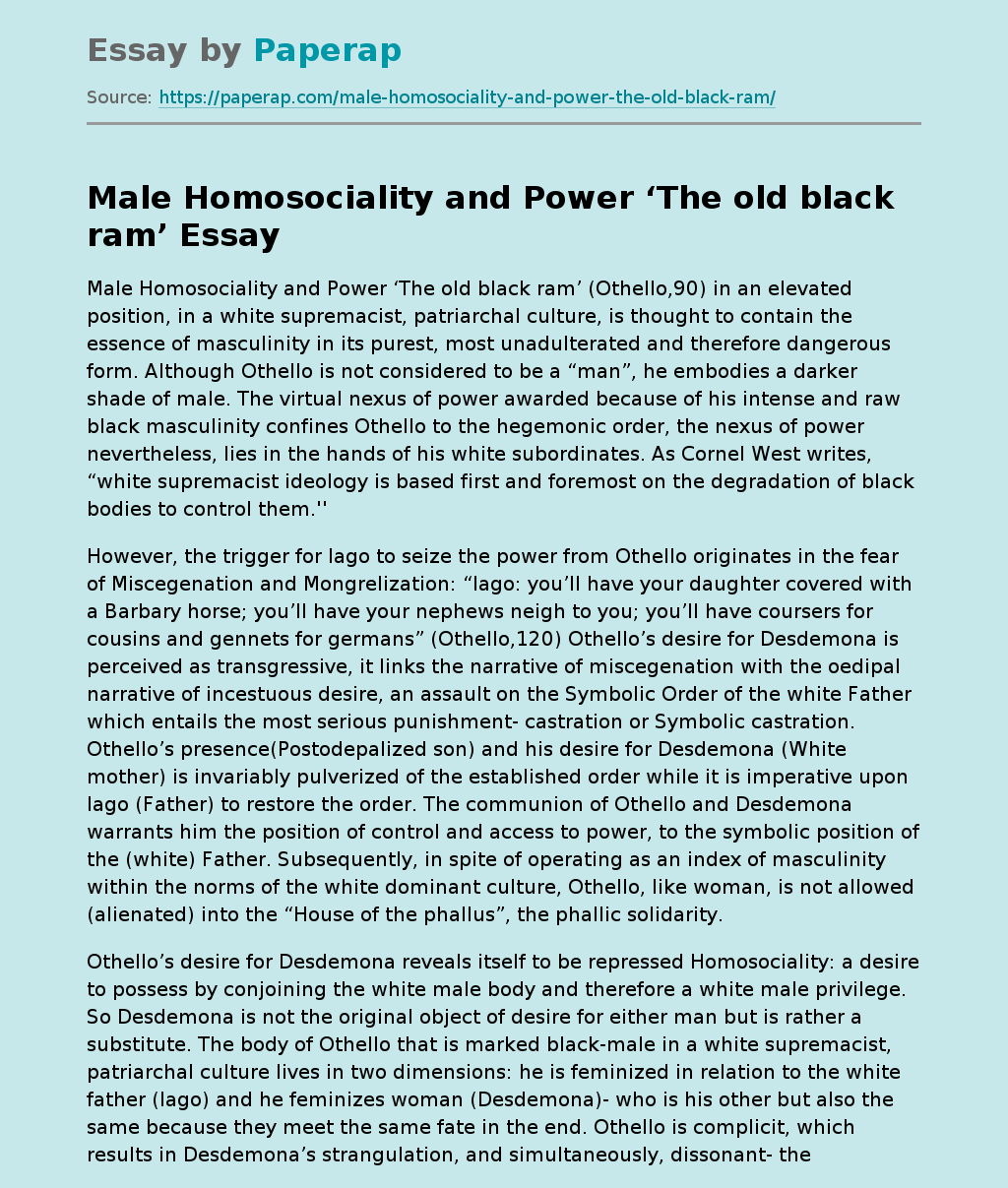Male Homosociality and Power ‘The old black ram’
Male Homosociality and Power ‘The old black ram’ (Othello,90) in an elevated position, in a white supremacist, patriarchal culture, is thought to contain the essence of masculinity in its purest, most unadulterated and therefore dangerous form. Although Othello is not considered to be a “man”, he embodies a darker shade of male. The virtual nexus of power awarded because of his intense and raw black masculinity confines Othello to the hegemonic order, the nexus of power nevertheless, lies in the hands of his white subordinates.
As Cornel West writes, “white supremacist ideology is based first and foremost on the degradation of black bodies to control them.”
However, the trigger for Iago to seize the power from Othello originates in the fear of Miscegenation and Mongrelization: “Iago: you’ll have your daughter covered with a Barbary horse; you’ll have your nephews neigh to you; you’ll have coursers for cousins and gennets for germans” (Othello,120) Othello’s desire for Desdemona is perceived as transgressive, it links the narrative of miscegenation with the oedipal narrative of incestuous desire, an assault on the Symbolic Order of the white Father which entails the most serious punishment- castration or Symbolic castration.
Othello’s presence(Postodepalized son) and his desire for Desdemona (White mother) is invariably pulverized of the established order while it is imperative upon Iago (Father) to restore the order. The communion of Othello and Desdemona warrants him the position of control and access to power, to the symbolic position of the (white) Father.
Subsequently, in spite of operating as an index of masculinity within the norms of the white dominant culture, Othello, like woman, is not allowed (alienated) into the “House of the phallus”, the phallic solidarity.
Othello’s desire for Desdemona reveals itself to be repressed Homosociality: a desire to possess by conjoining the white male body and therefore a white male privilege. So Desdemona is not the original object of desire for either man but is rather a substitute. The body of Othello that is marked black-male in a white supremacist, patriarchal culture lives in two dimensions: he is feminized in relation to the white father (Iago) and he feminizes woman (Desdemona)- who is his other but also the same because they meet the same fate in the end. Othello is complicit, which results in Desdemona’s strangulation, and simultaneously, dissonant- the late rebellion of ensuring Iago’s captivity, with the Law of the Father. Othello’s situation of attempting to situate himself with respect to powerful Iago(White Father) and a beloved mother (Desdemona) resembles Freud’s schematization of ‘The Oedipal Triangle. ‘In the normal boy’s development towards heterosexuality, Freud Insisted, he must pass through the stage of the, “ ‘positive Oedipus’, a homoerotic identification with his father ,a position of effeminized subordination to his father as a condition of finding a model for his own heterosexual role” (Richard Klien)
The bond between Iago and Othello draws from Heidi Hartmann’s definition of Patriarchy which asserts that the relations between men, though hierarchical, establish ‘interdependence and solidarity that enable them to dominate woman’. In Desdemona, a similar homosocial erotic triangle is foregrounded through the graphic image of rape by Othello and Iago of old women. In this Erotic triangulation, the passivity of (weak) women and their violence serves perfectly as a conduit facilitating a homosocial relation. Along with its erotic component, then, this is a bond of mentorship, Othello apprentices in the ways and virtues of the white citizenship (Plato’s Symposium) whose privilege and power he inherits. The sexual possession of women by Othello and Iago reduces Homosociality exclusively to a heteronormative act performed to defend their privileges and positions.The absorption of the ultimate white supremacist power by Othello is here linked to sadomasochism: “Othello: You don’t understand. Shame, yes, but worse. There was a pleasure too. The look between us was not to acknowledge shame, but mutual pleasure. Pleasure in the degradation we had caused; more pleasure in leaving a witness to it.” (Desdemona) Female Homosociality and Liberation In her development towards heterosexual relations, Desdemona identifies with her mother as a condition of finding a model for her own heterosexual role.
Peculiarly, Desdemona’s preadolescent stage is exposed to the incongruity of her mother’s feminine invisibility with Barbary’s (her mother’s maid) maternal intimacy. Throughout Othello, Desdemona follows the model of being complicit and invisible -the role epitomized by the mother in relation to the father. In the climax, however, as she places her feet on the ladder leading to her death, Desdemona’s thoughts ultimately go to Barbary. This fits exactly to Girard’s notion, “as he places his feet on the ladder, the lover’s ultimate thoughts go to the husband…” In Desdemona, the dark and heavy curtain’ (feminine invisibility) that enclosed her found a slit in the oriental tales, reminiscent of her repressed desire for freedom and adventure, narrated by Barbary and later, by Othello. Morrison consigns risk to the homoerotic triangle by the inclusion of an outside female subject (Barbary) with whom the female within the triangle (Desdemona) can relate to. The fourth party, outside the triangular constellation, in homosocial relations with the female within, annihilates the central triangle. The abolition of the triangle further negates the objectification of Desdemona by active men in the constellation and liberates her from the passivity and invisibility. Therefore, here, the female homosociality, unlike its counterpart, is based on emotional closeness, intimacy and a non-profitable form of companionship rather than erotic desire.
Male Homosociality and Power ‘The old black ram’. (2021, Feb 19). Retrieved from https://paperap.com/male-homosociality-and-power-the-old-black-ram/

